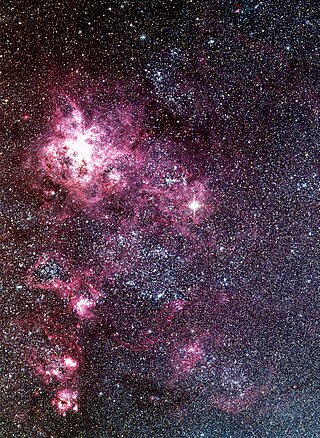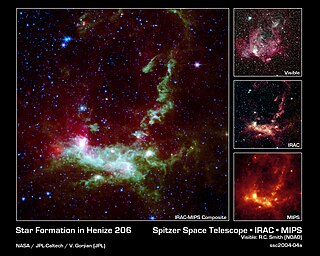
A nebula is a distinct luminescent part of interstellar medium, which can consist of ionized, neutral or molecular hydrogen and also cosmic dust. Nebulae are often star-forming regions, such as in the "Pillars of Creation" in the Eagle Nebula. In these regions, the formations of gas, dust, and other materials "clump" together to form denser regions, which attract further matter, and eventually will become dense enough to form stars. The remaining material is then thought to form planets and other planetary system objects.

A supernova is a powerful and luminous explosion of a star. A supernova occurs during the last evolutionary stages of a massive star or when a white dwarf is triggered into runaway nuclear fusion. The original object, called the progenitor, either collapses to a neutron star or black hole, or is completely destroyed to form a diffuse nebula. The peak optical luminosity of a supernova can be comparable to that of an entire galaxy before fading over several weeks or months.

Stellar evolution is the process by which a star changes over the course of time. Depending on the mass of the star, its lifetime can range from a few million years for the most massive to trillions of years for the least massive, which is considerably longer than the current age of the universe. The table shows the lifetimes of stars as a function of their masses. All stars are formed from collapsing clouds of gas and dust, often called nebulae or molecular clouds. Over the course of millions of years, these protostars settle down into a state of equilibrium, becoming what is known as a main-sequence star.

SN 1987A was a type II supernova in the Large Magellanic Cloud, a dwarf satellite galaxy of the Milky Way. It occurred approximately 51.4 kiloparsecs from Earth and was the closest observed supernova since Kepler's Supernova. 1987A's light reached Earth on February 23, 1987, and as the earliest supernova discovered that year, was labeled "1987A". Its brightness peaked in May, with an apparent magnitude of about 3.

The Large Magellanic Cloud (LMC) is a satellite galaxy of the Milky Way. At a distance of around 50 kiloparsecs (160 kly), the LMC is the second- or third-closest galaxy to the Milky Way, after the Sagittarius Dwarf Spheroidal (c. 16 kpc (52 kly) away) and the possible dwarf irregular galaxy called the Canis Major Overdensity. Based on the D25 isophote at the B-band (445 nm wavelength of light), the Large Magellanic Cloud is about 9.86 kpc (32.2 kly) across. It is roughly one-hundredth the mass of the Milky Way and is the fourth-largest galaxy in the Local Group, after the Andromeda Galaxy (M31), the Milky Way, and the Triangulum Galaxy (M33).

SN 1604, also known as Kepler's Supernova, Kepler's Nova or Kepler's Star, was a Type Ia supernova that occurred in the Milky Way, in the constellation Ophiuchus. Appearing in 1604, it is the most recent supernova in the Milky Way galaxy to have been unquestionably observed by the naked eye, occurring no farther than 6 kiloparsecs from Earth. Before the adoption of the current naming system for supernovae, it was named for Johannes Kepler, the German astronomer who described it in De Stella Nova.

A supernova remnant (SNR) is the structure resulting from the explosion of a star in a supernova. The supernova remnant is bounded by an expanding shock wave, and consists of ejected material expanding from the explosion, and the interstellar material it sweeps up and shocks along the way.

The Crab Nebula is a supernova remnant and pulsar wind nebula in the constellation of Taurus. The common name comes from William Parsons, 3rd Earl of Rosse, who observed the object in 1842 using a 36-inch (91 cm) telescope and produced a drawing that looked somewhat like a crab. The nebula was discovered by English astronomer John Bevis in 1731, and it corresponds with a bright supernova recorded by Chinese astronomers in 1054. The nebula was the first astronomical object identified that corresponds with a historically-observed supernova explosion.

A magnetar is a type of neutron star with an extremely powerful magnetic field (∼109 to 1011 T, ∼1013 to 1015 G). The magnetic-field decay powers the emission of high-energy electromagnetic radiation, particularly X-rays and gamma rays.
A Thorne–Żytkow object, also known as a hybrid star, is a conjectured type of star wherein a red giant or red supergiant contains a neutron star at its core, formed from the collision of the giant with the neutron star. Such objects were hypothesized by Kip Thorne and Anna Żytkow in 1977. In 2014, it was discovered that the star HV 2112, located in the Small Magellanic Cloud (SMC), was a strong candidate. Another possible candidate is the star HV 11417, also located in the SMC.

Hodge 301 is a star cluster in the Tarantula Nebula, visible from Earth's Southern Hemisphere. The cluster and nebula lie about 168,000 light years away, in one of the Milky Way's orbiting satellite galaxies, the Large Magellanic Cloud.

Cassiopeia A (Cas A) is a supernova remnant (SNR) in the constellation Cassiopeia and the brightest extrasolar radio source in the sky at frequencies above 1 GHz. The supernova occurred approximately 11,000 light-years (3.4 kpc) away within the Milky Way; given the width of the Orion Arm, it lies in the next-nearest arm outwards, the Perseus Arm, about 30 degrees from the Galactic anticenter. The expanding cloud of material left over from the supernova now appears approximately 10 light-years (3 pc) across from Earth's perspective. It has been seen in wavelengths of visible light with amateur telescopes down to 234 mm (9.25 in) with filters.
Supernova nucleosynthesis is the nucleosynthesis of chemical elements in supernova explosions.
The SuperNova Early Warning System (SNEWS) is a network of neutrino detectors designed to give early warning to astronomers in the event of a supernova in the Milky Way, our home galaxy, or in a nearby galaxy such as the Large Magellanic Cloud or the Canis Major Dwarf Galaxy.

The following outline is provided as an overview of and topical guide to astronomy:

A Type Ia supernova is a type of supernova that occurs in binary systems in which one of the stars is a white dwarf. The other star can be anything from a giant star to an even smaller white dwarf.

IC 443 is a galactic supernova remnant (SNR) in the constellation Gemini. On the plane of the sky, it is located near the star Eta Geminorum. Its distance is roughly 5,000 light years from Earth.

Gamma-ray burst progenitors are the types of celestial objects that can emit gamma-ray bursts (GRBs). GRBs show an extraordinary degree of diversity. They can last anywhere from a fraction of a second to many minutes. Bursts could have a single profile or oscillate wildly up and down in intensity, and their spectra are highly variable unlike other objects in space. The near complete lack of observational constraint led to a profusion of theories, including evaporating black holes, magnetic flares on white dwarfs, accretion of matter onto neutron stars, antimatter accretion, supernovae, hypernovae, and rapid extraction of rotational energy from supermassive black holes, among others.

Henize 206 is a nebula in the Large Magellanic Cloud. This luminous cloud of gas and dust houses a cluster of newborn stars. Although Henize 206 was first catalogued in the 1950s, it was reported in NASA press releases in March 2004, for showing several example images generated from the various infrared cameras on the Spitzer Space Telescope launched in August 2003.

iPTF14hls is an unusual supernova star that erupted continuously for about 1,000 days beginning in September 2014 before becoming a remnant nebula. It had previously erupted in 1954. None of the theories nor proposed hypotheses fully explain all the aspects of the object.
















